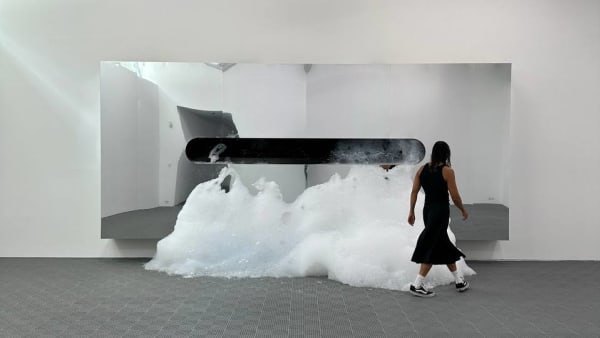

How ‘Echoic Choir’ brought the club back to CTM Festival
The show is the latest example of works using limitations as a parameter of creative expression
Imagine a rave. Bodies moving in synchronicity, sweat dripping down a shoulder, repetitive sounds rolling on into what feels like an endless loop, an ecstatic release. These feelings of collective joy, a term coined by cultural critic Barbara Ehrenreich in her book Dancing in the Streets, have been central to people’s wellbeing for centuries. But what happens when for a sustained period of time–say, over the course of a 21-month-long ongoing pandemic–pleasurable, communal revelry is cancelled?
Although published over a decade before the emergence of Covid-19, the book’s key thesis provides valuable context for Echoic Choir, the latest collaboration between Norwegian vocalist Stine Janvin and Canadian-Polish choreographer Ula Sickle. During the first lockdown, Janvin and Sickle felt the intimacy of dancing in a club gradually slipping into a vague memory buried deep within them. “Despite the restrictions, we still had this longing for collective space,” Janvin explained. “We decided to use that as a starting point, asking questions like, ‘What is it about that collective space that we miss? What is its function? Why is this ritual necessary?’”
Echoic Choir‘s Berlin debut recently took place as part of this year’s Club Transmediale Festival (CTM)–a natural fit for the festival’s “Transformation” theme. Within the roughly hour-long show, an ensemble of six performers transformed the space into a re-interpretation of the club environment. The interdisciplinary show asked the audience to take part in their “collective ritual” in which the performers moved around the space, creating club-like beats and rhythms with their voices. A highly interdisciplinary piece, Echoic Choir includes poetry written by the Dutch writer Persis Bekkering, and custom costumes designed by Joelle Läderach.
The starting point for Echoic Choir is a vocal technique that Stine Janvin developed in 2018 called Fake Synthetic Music–music that sounds synthetic, but is produced solely with the human voice. Though Janvin’s work experiments with artifice, she and Sickle assert that their mission was not to replace the club, but rather to reinterpret the space into something more malleable.
We met Janvin and Sickle between rehearsals in Berlin to learn more about the concept of Fake Synthetic Music, the necessity of collective rituals, and their hopes for the future of clubbing.

EB: Echoic Choir is, in essence, an ode to the club. I wonder what your personal relationship to club culture is.
Ula Sickle: I have a very nostalgic memory of club culture as someone who went raving in the 90s. So much of that period has come back, and right now there are so many specific [aesthetic] references to the late nineties. At the same time, my connection to the club is very emotional: I love to be on the dance floor, and it’s a super creative space for me as a choreographer.
Stine Janvin: When I first came to Berlin–it’s like a classic story–I never experience club life like that before. So I was really excited and fascinated by the community feeling in the club and the myriad genres and styles that I experienced.
As an artist, the after-parties at festivals like CTM and Unsound were also an important part of my club experience. Although I’m more of an eager observer when I’m there.
EB: How did you develop the idea for Echoic Choir?
Ula Sickle: Stine and I have collaborated a couple of times already, always trying to find this intersection between the voice and the body. We made a performance together and at some point, Stine contacted me and asked if I would like to work on a larger scale production inspired by her practice Fake Synthetic Music.
Stine Janvin: When the pandemic ‘hit’ our focus shifted. I was thinking about how we could incorporate that sort of provision, and also the danger of being in a room together with other people. Despite restrictions, we still had this longing for collective space. And we decided to use that as a starting point, asking questions like, ‘What is it about that collective space that we miss? What is its function? What does that ritual, um, why is that ritual necessary?’
This element will show content from various video platforms.
If you load this Content, you accept cookies from external Media.
EB: The show is opening at an interesting time, with indoor spaces in Berlin opening up as part of new legislation allowing the vaccinated and people who have recovered from Covid-19 to attend cultural events like performances, concerts, and clubs. How does it feel to present Echoic Choir at this time?
Ula Sickle: We tried to just be as resilient as possible, basically. So we even had [different] versions of the show, depending on if we can only be outdoors, or if we’re indoors, but with certain dimensions and measurement distances. So we really took those restrictions as artistic parameters.
Stine Janvin: It’s not like we’re trying to replace a real club experience. Rather, it’s a comment on what was missing at that time and is still missing, a bit.
Ula Sickle: What we’re trying to do is create a space where you can access your memory of being in a club, but then also kind of have a more reflective space where other thought processes can happen than when you’re really immersed completely [in the club atmosphere].
In that sense, physical distancing measures and the parameters created a possibility to revisit a familiar scenario with a bit of distance. We’re not proposing this is an alternative, necessarily.
Stine Janvin: The musical material also reflects this conceptually because there’s no bass, no drums, there is only the voice and the body.
The musical material also reflects this conceptually because there’s no bass, no drums, there is only the voice and the body.





Ula Sickle: We’re not trying to replace the club, but rather to embody it. We try to embody the club and transmit that to an audience. So we are the music. We are the speaker system. I mean, we’re complemented by some technology, but we are transmitting the club in a physical way through our bodies and voices.
EB: How did you manage rehearsals during this time?
Stine Janvin: We were actually very privileged [in that] we didn’t do any Zoom rehearsals or anything like that. We had like a wonderful space provided by the DAAD (German academic exchange program) with a really good ventilation system and a regular testing schedule. That was a huge benefit for us.
Ula Sickle: It’s funny how physical proximity becomes a privilege. It’s the same with clubs. I hope that when people step into the club nowadays, they remember what a privilege it is to be able to be together with people like that again.
EB: With the curfew on events lifting, it will be interesting to see this shift in perspective.
Ula Sickle: It’s funny because we were even contemplating to do the show at 11 [pm] and they were like, Berlin’s not ready!
I hope that people remember what a privilege it is [to be in a club] again.
View this post on Instagram
This interview has been condensed and edited for clarity. Echoic Choir will be performed at STUK in Leuven, Belgium, on October 5th. Find tickets here.
Published September 20, 2021. Words by Caroline Whiteley, photos by Camille Blake.






Follow @electronicbeats